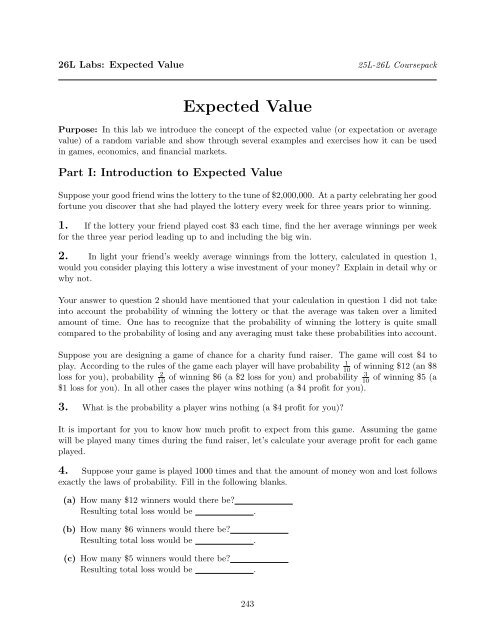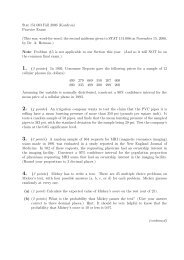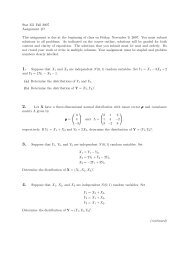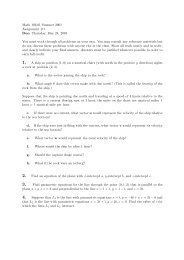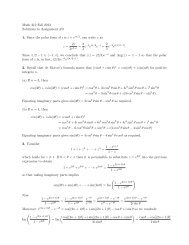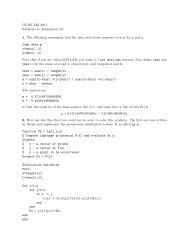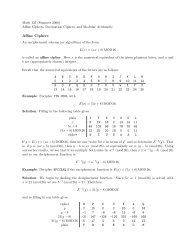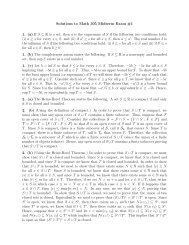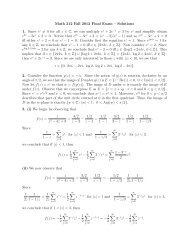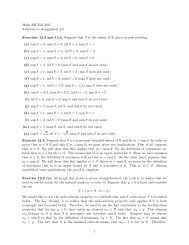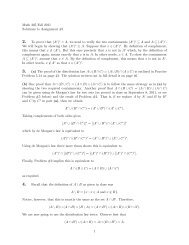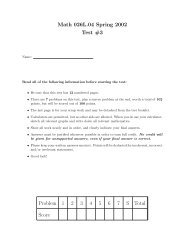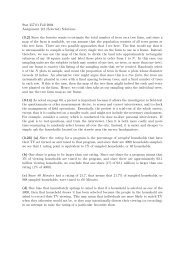Expected Value
Expected Value
Expected Value
Create successful ePaper yourself
Turn your PDF publications into a flip-book with our unique Google optimized e-Paper software.
26L Labs: <strong>Expected</strong> <strong>Value</strong>25L-26L Coursepack<strong>Expected</strong> <strong>Value</strong>Purpose: In this lab we introduce the concept of the expected value (or expectation or averagevalue) of a random variable and show through several examples and exercises how it can be usedin games, economics, and financial markets.Part I: Introduction to <strong>Expected</strong> <strong>Value</strong>Suppose your good friend wins the lottery to the tune of $2,000,000. At a party celebrating her goodfortune you discover that she had played the lottery every week for three years prior to winning.1. If the lottery your friend played cost $3 each time, find the her average winnings per weekfor the three year period leading up to and including the big win.2. In light your friend’s weekly average winnings from the lottery, calculated in question 1,would you consider playing this lottery a wise investment of your money? Explain in detail why orwhy not.Your answer to question 2 should have mentioned that your calculation in question 1 did not takeinto account the probability of winning the lottery or that the average was taken over a limitedamount of time. One has to recognize that the probability of winning the lottery is quite smallcompared to the probability of losing and any averaging must take these probabilities into account.Suppose you are designing a game of chance for a charity fund raiser. The game will cost $4 toplay. According to the rules of the game each player will have probability 1 10of winning $12 (an $8loss for you), probability 2310of winning $6 (a $2 loss for you) and probability10of winning $5 (a$1 loss for you). In all other cases the player wins nothing (a $4 profit for you).3. What is the probability a player wins nothing (a $4 profit for you)?It is important for you to know how much profit to expect from this game. Assuming the gamewill be played many times during the fund raiser, let’s calculate your average profit for each gameplayed.4. Suppose your game is played 1000 times and that the amount of money won and lost followsexactly the laws of probability. Fill in the following blanks.(a) How many $12 winners would there be?Resulting total loss would be .(b) How many $6 winners would there be?Resulting total loss would be .(c) How many $5 winners would there be?Resulting total loss would be .243
26L Labs: <strong>Expected</strong> <strong>Value</strong>25L-26L Coursepack(d) How many $0 winners would there be?Resulting total profit would be .(e) What would be the net total profit (loss) from these 1000 games?(f) What would be the average profit (loss) per game?5. Explain why the following calculation yields the expected average profit per game when thegame is played 1000 times.110 (1000)(−$8) + 210 (1000)(−$2) + 3 10 (1000)(−$1) + 4 10 (1000)($4)10006. Using the same assumptions, compute the expected average profit per game when the gameis played 5000 times.7. Notice that the 1000 and the 5000, in the above calculations, can be canceled from thenumerator and denominator leaving us with110 (−8) + 210 (−2) + 3 10 (−1) + 4 (4) = 0.10.10Assuming the winning amounts remain the same, what would you have to charge to play the gameif you wanted the expected average profit per game to be $0.50?The average value calculated by the expression in question 5 is called a weighted average becausethe average is weighted by the probabilities of the events happening. This type of weighted averageis also known as the expected value of the experiment.Let X be a random variable with mass density p(x). The expected value of X is denoted by E(X)and is defined to beE(X) =∑x · p(x).{x|p(x)>0}Simply stated, to find the expected value of a random variable you multiply every outcome by theprobability of that outcome happening, then add the resulting products.8. Find the expected value of your profit from purchasing a $3 lottery ticket on a two million1dollar jackpot, assuming the probability of winning the jackpot is . Is your computed4, 000, 000value of E(X) consistent with what you would “expect” to happen?Remember that the expected value of a random variable is its average value if the experiment isperformed many times.244
26L Labs: <strong>Expected</strong> <strong>Value</strong>25L-26L CoursepackPart II: A Game of ChanceIn this part of the lab you will play a game of chance, record the results and compare your averagewinnings per game with the calculated expected winnings.Experiment: In this game you will roll a fair die until one of the numbers 1, 2, 3, or 4 turns up.If it takes you n rolls to get a 1, 2, 3, or 4 you win $2 n . So, for example, if it takes you three rollsto get a 1, 2, 3, or 4, you win $2 3 = $8. In order to prevent a game from going on too long we willlimit the number of possible rolls to 8. That is, the most you can win is $2 8 = $256. If you havenot rolled a 1, 2, 3, or 4 after 8 rolls then the game ends and you win $0. Play the game 20 timesand record the results in the table.game # 1 2 3 4 5 6 7 8 9 10 11 12 13 14 15 16 17 18 19 20$ wonLab GroupClass ResultsTotal winnings = Total winnings =Average winnings per game = Average winnings per game =Let X be the random variable whose value is the number of rolls you made in a given game.1. What is the probability that X = 1?2. What is the probability that X = 2? that X = 3? Note that if X = 2 then you did not geta 1, 2, 3, or 4 on the first roll, but you did get a 1, 2, 3, or 4 on the second roll.3. What is the probability that X = n?4. There are nine different amounts that can be won playing this game. Use the probability ofwinning these amounts to calculate the expected winnings per game.5. Compare the average winnings in our experiment with the expected winnings you calculatedin question 4. Are the values close? Explain why they could differ and how the experiment mightbe changed to bring the values closer together.Part III: ExercisesThe Math 26L supplement entitled “Probability III: Expectation and Options” contains explanationsand worked examples related to the expected value of a random variable. At the end of thesupplement are problems which will give you practice calculating expected value. Work throughproblems 1, 2, 4, 5, 7, 8, 9, 11.245


